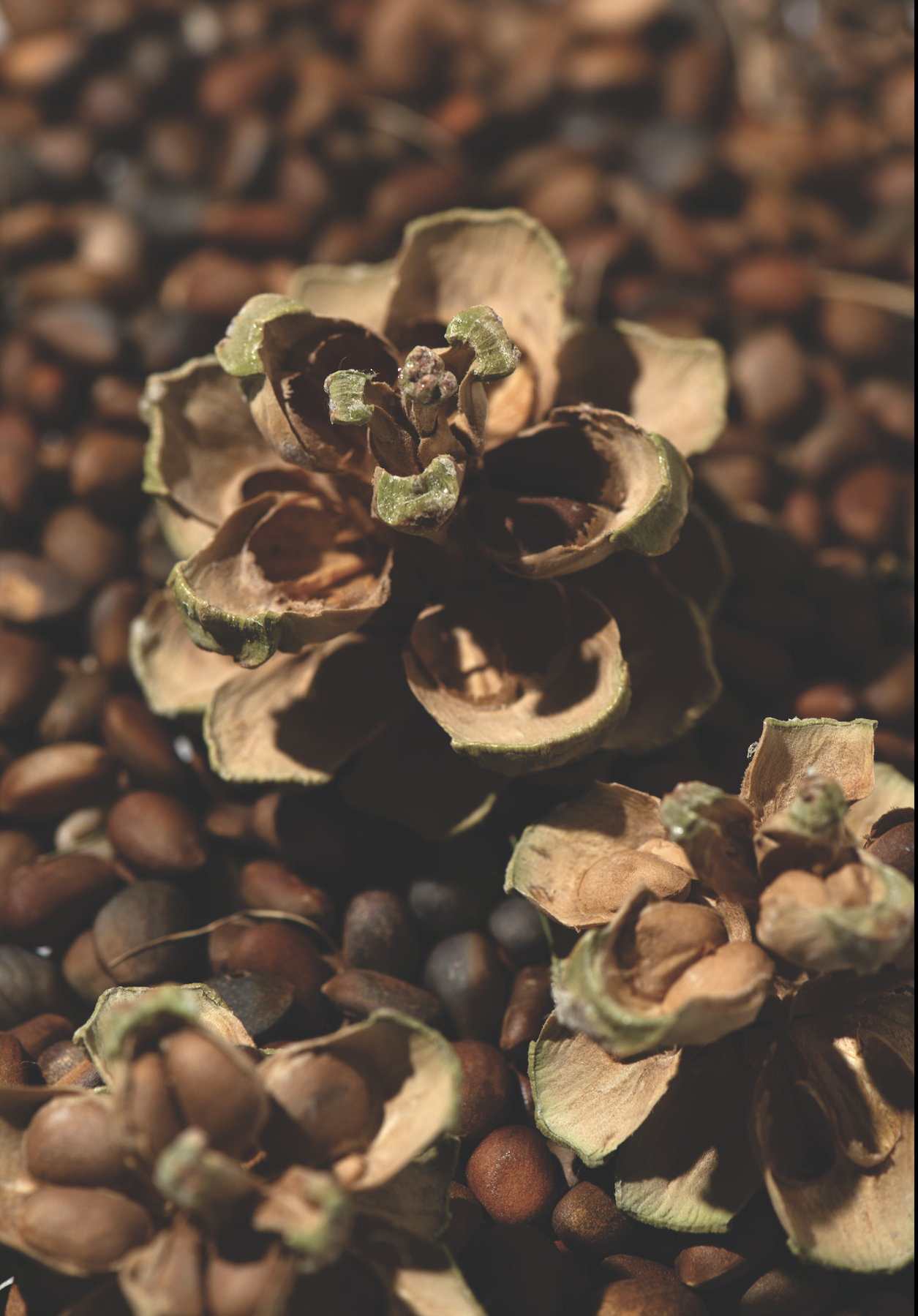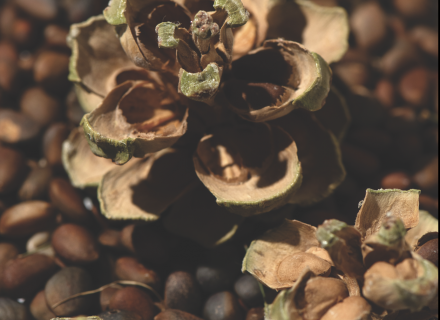The piñon nut, the hand-harvested culinary treasure of the Southwest, is a prized ingredient in Native American cooking, and we’ve got some recipes.
The piñon pine provides more than just nuts for cuisine. Its essence is infused into perfumes and oils. Its wood is chopped for scented fires, and its dried-up cones are used for fire starters.
“I was always taught to find the benefits in all parts of a tree, plant, or resource and to use every ounce of a living object to the fullest,” says Candace Samora (Apache, Pascua Yaqui, Navajo), who grew up in the Roaring Fork Valley of Colorado surrounded by piñon pine trees. “My ancestors and generations of my family can find value in every nuance of our land and use it to nurture our communities.”
Chief operating officer for the Indian Pueblo Cultural Center Monique Fragua (Pueblo of Jemez, New Mexico) adds that the pine tree is a reminder of the land and simpler times. After years of waiting for the piñon to produce, the harvest is cause for celebration and a potent symbol of New Mexico and simpler times. “From burning the scaly effervescent wood in winter to collecting and decorating pine cones for ornaments to listening to community members who’ve trekked out and picked piñon nuts, the piñon to me is family and a celebrated tradition of New Mexico.”
 PHOTOGRAPHY: Julie Bielenberg
PHOTOGRAPHY: Julie Bielenberg
In the Kitchen
Piñon pine nuts, also called piñones, are a hand-harvested culinary treasure of the Southwest and a prized ingredient in Native American cooking. The nuts are usually smaller than the average pine nut and have a richer, more buttery flavor, with a higher fat content.
Outside of New Mexico, it’s extremely challenging to find true piñon cuisine or beverages on any menu. New Mexico Piñon Nut Company is the only consistent source of piñon. If you can’t find or afford piñon pine nuts to make these dishes at home, regular pine nuts will do in a pinch.
Here are some recipes to try out.
 PHOTOGRAPHY: Chad Chisholm Creative
PHOTOGRAPHY: Chad Chisholm Creative
Roasted Green Chile And Piñon Pancakes
Courtesy of Cheryl Valadez, AlbuKirky Seasonings (albukirkyseasonings.com)
Makes approximately 12 5-inch pancakes.
Ingredients
2 cups all-purpose flour
4 teaspoons baking powder
½ teaspoon kosher salt
4 tablespoons sugar
1¾ cup whole milk
2 large eggs, lightly beaten
4 tablespoons butter, melted and cooled
2 teaspoons vanilla extract
¼ cup toasted piñons, shelled
¼ cup – ⅓ cup diced roasted green chile, seeded and well-drained
Instructions
In a large bowl, whisk together flour, baking powder, salt, and sugar. In a separate bowl, mix together milk, lightly beaten eggs, melted butter, and vanilla extract.
Make a well in the center of the dry ingredients and pour the milk mixture into the center. Using a fork, gently mix everything together just until blended. To the batter, add the toasted piñons and the diced green chile. Again, using a fork, mix all ingredients together just until blended. Set batter aside and let it rest for 10 minutes.
Heat large griddle or nonstick pan over medium heat for 4 – 5 minutes. Add a small amount of neutral oil such as canola to the pan and wipe with a paper towel to spread it around the surface.
Using a ⅓ cup measuring cup (or ¼ cup for smaller pancakes), spoon batter onto pan/griddle and spread it around slightly to form a 5-inch circle. Let cook until the surface begins to show signs of bubbling. Check the bottom, and when it is a deep golden brown, flip the pancake and let cook on the other side. Cook until the bottom is deep gold brown and the top of the pancake springs back when gently pressed.
Repeat for each pancake, being sure to add oil to the pan between each one. Serve immediately with butter and syrup. Leftover pancakes can be stored in the freezer for up to three months. Place a piece of wax paper in between each pancake for easy removal.
Mugolio (Pine Cone Syrup)
Courtesy Julie Bielenberg, Colorado-based writer
According to Forage Colorado, pine cone syrup’s origin seems to be in the Italian Alps. The region is part of the native range of the Mugo pine, Pinus mugo, which is where the word mugolio comes from. Mugo refers to the tree, and olio means oil in Italian. (foragecolorado.com). This mugolio recipe comes from Spring Valley, Colorado. Pine syrup is an earthy, dark-amber delicacy that takes weeks to form and lasts for months. Although a relatively simple process, the syrup needs sunlight and time for best results. Depending on where the syrup is made, additional regional ingredients can be used as sweeteners. In Colorado’s Roaring Fork Valley, residents have planted apple trees alongside the piñon pine trees. The apples ripen just as the piñon cones begin to burst with their seeds. Locals will dehydrate the apples in the sun or with a dehydrator and add a half cup of dried applies to the raw sugar during the process for an extra flavor and saccharine delight.
Ingredients
10 – 12 green piñon pine cones, with nut pods completely encased in the cone (The cones should be very green and oozing with sap.)
2 – 3 cups raw sugar
½ cup dehydrated apples (measure after dehydrating)
12 16-ounce wide-mouth Mason jars
1 lemon
Instructions
Place pine cones and sugar in a dry sterilized jar with lid. Move to a sunny spot, such as a window. Rotate the jar every couple of days and make sure to loosen the lid for a couple of seconds to allow the jar to breathe. Seal and place back in the sun. Repeat this for a few weeks until the dark amber syrup begins to fill up from the bottom of the Mason jar.
After the desired syrup has accumulated, add the contents to a pot and boil for 4 to 5 minutes. You may need to add a bit of water or lemon juice for consistency. Add the dried apples. Bring to a rapid boil for 3 minutes. Skim the froth off the top and remove pine cones. Let syrup cool and thicken. Serve or store in Mason jars.
Cilantro Jalapeño Piñon Pesto
Courtesy of Tuesday Foods, organic plant-based meal delivery in Carbondale, Colorado (tuesdayfoods.co)
Makes 4 4-ounce servings.
Enjoy this pesto as a dip for veggies or crackers, as a sandwich spread, or tossed with your favorite pasta. The dip makes a beautiful salad dressing by adding more water. It also pairs well with chicken or salmon.
Ingredients
2 small bunches cilantro
½ cup pine nuts
½ cup almonds, toasted
1 lemon, juice and zest
1 jalapeño, halved and seeds removed
2 teaspoons tamari
1 tablespoon capers, drained
2 cloves garlic
¼ cup extra virgin olive oil
¼ cup water (plus more for consistency)
Sea salt to taste
Instructions
Clean and roughly chop cilantro. Toss almonds in a little olive oil and toast in 350-degree oven about 8 minutes (be careful not to burn).
In a food processor, combine cilantro, pine nuts, toasted almonds, lemon juice and zest, jalapeño, tamari, capers, and garlic. Pulse until finely ground, scraping down the sides when necessary. With the processor running, drizzle in the oil (the pesto will be thick at this point). Now, add water as needed to achieve desired consistency. Store in an airtight container in the refrigerator for up to 5 days.
Discover the history and cultural significance of the piñon nut and check out these 9 piñon essentials.
















